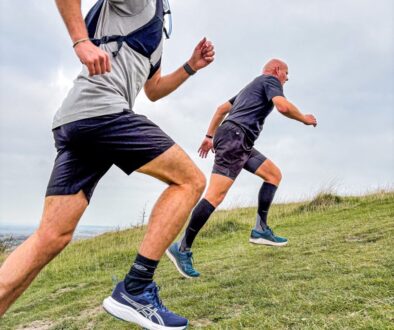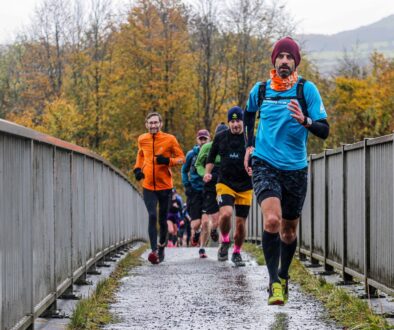One of the most appealing things to me about trail running is the variety of techniques required to cope with courses that weave their way up, down and round the hills. The Alpine trails that we offer at Run the Wild encompass all these elements, but it’s the descents that people often find the most challenging. This can be a particular issue for those who lack consistent access to hilly and varied terrain, which helps strengthen muscles and joints and ultimately increase speed and confidence over a variety of ground. Yet given the right approach to training and preparation, location need not be a barrier to developing your inner Chamois. Of all the aspects of trail running, time spent on developing your descending technique can bring the biggest gains to not only your ability but also your enjoyment out on the trail. It’s one of the great thrills of trail running to have the world passing by in a blur as you focus intently on the narrow tunnel of vision ahead of you with legs in full flow. However, great rewards also come with increased risks so it’s important to emphasise taking a cautious and patient approach. The elite runners make it look deceptively easy, but they’ve also had to train themselves up to this level of ability.
FOCUS, LOOK AFTER YOURSELF AND GO FOR IT!
Before we launch into the details, it’s important to begin with a few things in mind.
CONCENTRATE: When descending, the most important thing is getting through it uninjured. Speed, position, what you’re having for dinner etc. are rendered meaningless if you blow it at high speed through your mind wandering. Remain present and concentrate entirely on what you are doing and the ground ahead. It only takes a momentary lapse of concentration to invite disaster, particularly late in the day or race.
KEEP CONTROL: Choose trails that you know, or at least have walked or run round, to identify any hazards to be aware of. If there’s a cliff edge right next to a tight turn on the trail and you’re not in total control, then you’re asking for serious trouble. It’s better to be late in this world than early in the next: slow down, get past the hazard and then pick it up again. On a less serious but equally important note, particularly in the Autumnal season with leaves on the ground, exercise greater caution when it’s wet and slippery underfoot.
BE CONFIDENT: Your mind greatly influences how your body performs. So if you’re anxious or hesitant about running downhill, then chances are you’re going to tense up and lose the dynamism required to flow with the terrain. It’s obviously not as simple as immediately flicking a mental switch, but by choosing trails you know well and following the tips below, your confidence can grow as you gain more trust in what your body can do.
Practice, Practice, PRACTICE
Take time in your training to seek out progressively challenging hills and trails that you can use to build strength in your joints, ligaments and muscles, thereby giving you positive mental feedback to draw on. It’s helpful to focus on these key elements:
i. maintaining good form
ii. improving your feet-eye coordination and route choice
iii. developing your ‘gears’
To begin with opt for short, gradual hills that have a clear run out to enable you to focus on maintaining good form. Keep a slight forward lean from the ankles (rather than bowing forward at the waist), which will help your feet land under the body, and let your legs stretch out behind you. Do several repeats that should feel more exhilarating than exhausting. If you’re new to this, then starting conservatively on hills that take only a minute or so is good. You can then build up to longer hills as your body and confidence adjusts. Alongside these hillier sessions, you can also start venturing onto more technical trails to hone your feet-to-eye coordination (and strengthen your lateral ankle ligaments). These can either be on shallow gradient or even flat trails, since your primary goal should be to pick a good, fluid route to keep you moving efficiently. Adopt an active stance with bent knees. Keep your footsteps quick, short and light so you can switch direction quickly if hazards such as smooth wet rock slabs or slick tree routes need avoiding. Scan a few metres in front of you, picking out a path of least resistance to keep you moving freely and without massive strides or drop offs. If you tend to focus only on the next step then you’ll stall and slow down. You may need to walk sections if it gets too intricate, but hopefully within a few sessions you’ll feel able to run more.
PUTTING IT ALL TOGETHER
So as your hill sessions and your coordination improves, you will hopefully feel more confident to seek out steeper and more technical trails. Your form will have to adjust as the terrain steepens, requiring more control through leaning back and adopting a heel strike and a small stride. Your arms should also come more into play on technical trails to maintain balance and keep you upright. Keep them as wide and exaggerated as you like: it can often feel more like a dance than running! If you venture onto loose scree or mud it’s often a case of whatever it takes to ride the terrain and stay upright. Any skiing, snowboarding or skateboarding ability can serve you well in these situations. Finally, you should be able to seek out routes that encompass a variety of terrain that encompass all of these elements. This is where your gears come into play, since your technique will have to be adapted for each section, making for a continually interesting run that makes time and distance pass unnoticed. Just remember to have your watch with you if you have to be back at work.
WHAT GOES UP
Since your routes will feature both ups and downs, it’s important to be aware of transitioning from one to the other. When you crest the hill after a long, demanding ascent your muscles will need some time to adjust, so ease into the early part of the descent and gradually increase your speed. The biggest danger is catching a toe on a rock or root and tripping over (since you’re prone to forgetting to pick your feet up on tired legs after ascending), or landing awkwardly and twisting an ankle.
SMART TRAINING
To compliment your time on the trail, regular core work, squats, lunges and one foot balancing exercises using a wobble board or cushion can be effective. They don’t take long to implement in your training, and are a vital part of pre-hab and staying injury free. Ankle flexibility is particularly useful to work on since the trails are uneven and the ground underfoot can often take you by surprise. Heavy descending sessions can take a huge toll on the body, so it’s important to be sparing with them. Do no more than one of these every couple of weeks or longer, and remember that like any smart training, it’s a fine balance between consistency and intensity. Have fun and save the all out efforts for race day!
Written by Alistair Bignell, Run the Wild Guide



